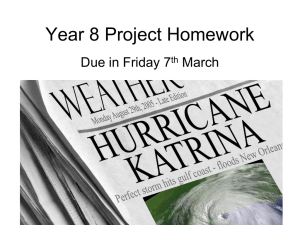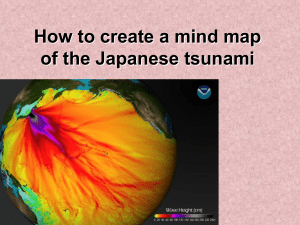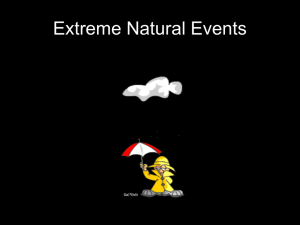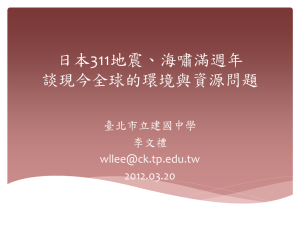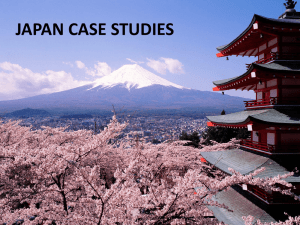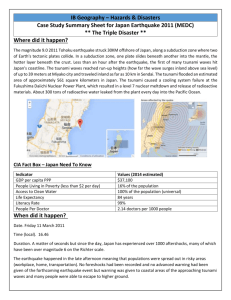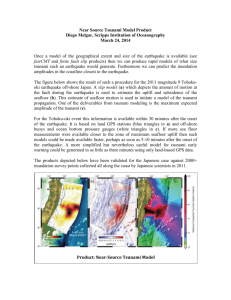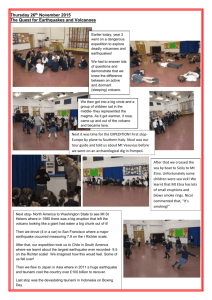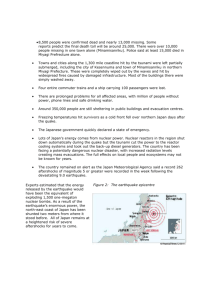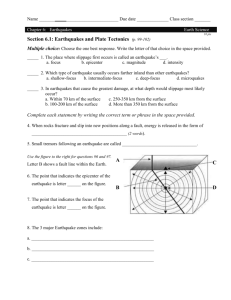File
advertisement
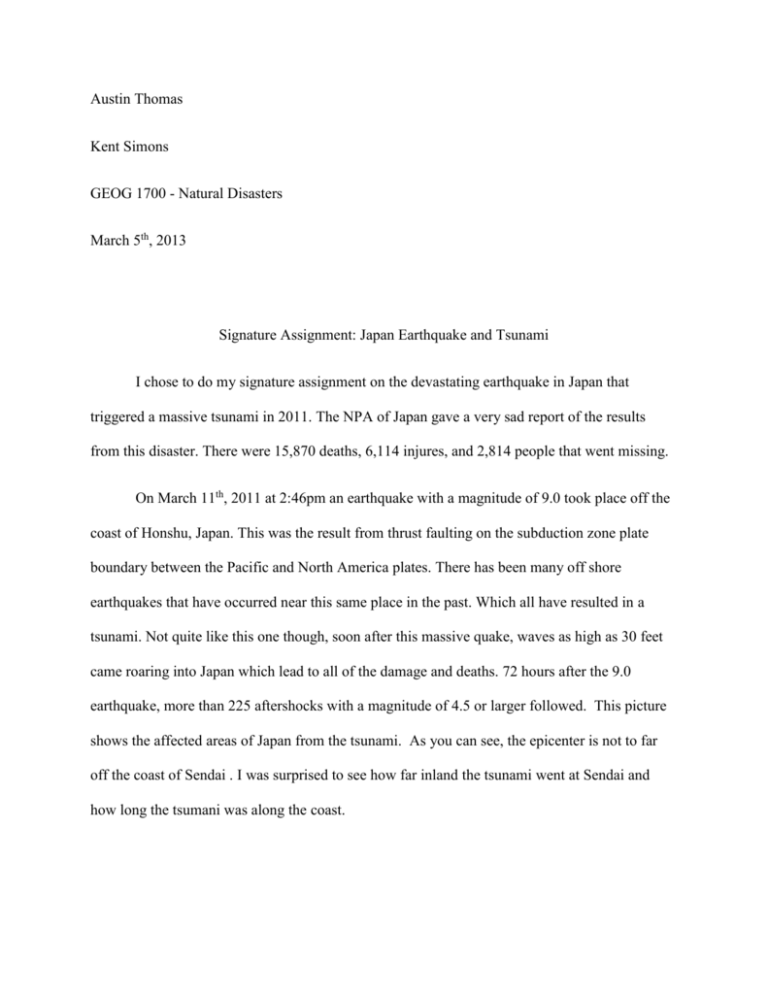
Austin Thomas Kent Simons GEOG 1700 - Natural Disasters March 5th, 2013 Signature Assignment: Japan Earthquake and Tsunami I chose to do my signature assignment on the devastating earthquake in Japan that triggered a massive tsunami in 2011. The NPA of Japan gave a very sad report of the results from this disaster. There were 15,870 deaths, 6,114 injures, and 2,814 people that went missing. On March 11th, 2011 at 2:46pm an earthquake with a magnitude of 9.0 took place off the coast of Honshu, Japan. This was the result from thrust faulting on the subduction zone plate boundary between the Pacific and North America plates. There has been many off shore earthquakes that have occurred near this same place in the past. Which all have resulted in a tsunami. Not quite like this one though, soon after this massive quake, waves as high as 30 feet came roaring into Japan which lead to all of the damage and deaths. 72 hours after the 9.0 earthquake, more than 225 aftershocks with a magnitude of 4.5 or larger followed. This picture shows the affected areas of Japan from the tsunami. As you can see, the epicenter is not to far off the coast of Sendai . I was surprised to see how far inland the tsunami went at Sendai and how long the tsumani was along the coast. And this following picture shows the intensity of the earthquake in different parts of Japan. I was not aware that nearly half of Japan was able to feel this earthquake. All of this chaos is caused by the Pacific plate thrusting under the North American plate which leads to a massive earthquake and usually follows with a deadly tsunami. I would never choose to live next to these plates. They are too dangerous for me, and are constantly moving. The earth’s plates move because the heat from the core of the earth causes molten rock in the mantle layer to move. And in a subduction zone, the plate that moves upward releases a large amount of energy and displaces a large amount of ocean water. As it comes closer to land it reaches shallower water and that is what makes to height of the wave to increase. This is all a natural process from the earth, if we weren’t here, this kind of event would actually be pretty beneficial to the earth. Giving land nutrients and water, and clearing away dead vegetation. But sense we are here these events become disasters and cause much heart ache. This earthquake and tsunami destroyed literally everything in its path, and left around 300 billion dollars in damage. Many fires broke out when gas lines got broken thousands of gallons of oil spilled into the ocean, and one of the scariest parts is when the nuclear power plant lost its cooling ability after the tsunami cut off the electricity to the backup generators. They had to evacuate around 3000 people living close to the power plant. But once they found out that radiation levels were 8 times the normal amount outside the plant they had to evacuate everyone that lived within 6.2 miles. The nuclear power plant leaking and all of the debris that was once made by humans had a huge contribution to the effects of this catastrophe. As you can see in picture one, thousands and thousands pounds of debris are collecting in the rushing water, causing much more damage to whatever it hits. It’s interesting; I used to think that tsunamis were ginormous waves that came crashing down on the land. But when I watched footage of this event, the tsunami really didn’t look to intimidating from afar. This kind of natural disaster is able to be forcasted, but with a large amount of wiggle room. Earthquakes can not be predicted, the only people that like to do that are those strange, money making dooms day preppers. So far they have always been wrong. So I never worry about peoples random predictions. Japan has the most advanced earthquake early warning systems on the planet. They have an online system that detects tremors and calculates an earthquakes epicenter and then sends out a quick warning from the seismographs that are scattered all across Japan. Its important that Japan has this technology because they seem to suffer the worse from earthquakes. People have these warnings sent to their phones or computers. They don’t give you whole lot of time, but they do help those people find saftey quicker. Tsunami warnings take longer to send out because there are many more calculations that are involved. So when this earthquake struck Japan, tsunami warnings were sent out a few minutes later. Which gave people roughly around 10-15 minutes to prepare for the hit. That is much better then having no warning at all. With out these warnings, thousands of more people would be killed. If it were me living on the coast of Japan, I would just run for the hills right after the earthquake happened, assuming that a tsunami was headed our way. Like I said earlier, I don’t think I could live in Japan, there is way to much risk. As you can see from the graph below, over half the population of Japan says the are extremely worried that an earthquake will occur. I would be apart of that 55%. This disaster has caused so much physical damage, but I believe the emotional and mental damages surpasses physical damages by far. You can see from the graph below that the Japanese population has increased drastically in the last 50 or 60 years. In the year 2010 they had a total population of 12955434 people. This is a very large amount of people for how small Japan is. So yes, the increase in human population and civilzation in the last 50 years has caused this disaster to become a catastrophe. 50 years ago, there were not nearly as many people or buildings, which would mean that it this disaster 50 years ago would not be nearly as devistating. Japan has done a lot to prepare for future earthquakes. They have warning systems that can be sent to every individual if they choose, similar to what we do here in Utah, they teach children what they should do when they are at school and have drills. All modern buildings are built with deep foundations and shock absorbers to help withstand earthquakes. I think that’s pretty much all you can do for an earthquake. Im not to sure if we have earthquake warning systems here in Utah. We should, because we all know that we are waiting for one to happen at any time. With todays technology, I believe that Japan could build steel barriars that pop up out of the ground along the coast. It would cost millions if not billions of dollars, but it would work, or at least mitigate the damage of the city. Reflective Writing: This class has hands down been the most interesting out of any other classes I have taken here at SLCC. I have learned so much about each natural disaster: such as how they start, where and when they usually occur, how long they last, how to mitigate them, and most importantly what to do when you get caught in them. I also have enjoyed the way my teacher, Kent Simons teaches and presents his class. He uses visual aids throughout the entire class that keeps me interested and helps me remember information better. Sites and sources: www.allinjapan.org http://www.nytimes.com/interactive/2011/03/11/world/asia/maps-of-earthquake-and-tsunamidamage-in-japan.html http://earthquake.usgs.gov/earthquakes/eqinthenews/2011/usc0001xgp/#summary http://poleshift.ning.com/profiles/blogs/11-march-2011-northern-japan http://www.huffingtonpost.com/2011/03/11/japan-earthquake-2011-nuclear-powerplant_n_834444.html http://www.time.com/time/world/article/0,8599,2059780,00.html
